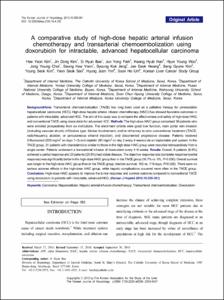KUMEL Repository
1. Journal Papers (연구논문)
1. School of Medicine (의과대학)
Dept. of Internal Medicine (내과학)
A comparative study of high-dose hepatic arterial infusion chemotherapy and transarterial chemoembolization using doxorubicin for intractable, advanced hepatocellular carcinoma
- Keimyung Author(s)
- Jang, Byoung Kuk; Hwang, Jae Seok
- Department
- Dept. of Internal Medicine (내과학)
- Journal Title
- Korean Jourmal of Hepatology
- Issued Date
- 2010
- Volume
- 16
- Issue
- 4
- Keyword
- Carcinoma; Hepatocellular; Hepatic arterial infusion chemotherapy; Transarterial chemoembolization; Doxorubicin
- Abstract
- Background/aims: Transarterial chemoembolization (TACE) has long been used as a palliative therapy for unresectable hepatocellular carcinoma (HCC). High-dose hepatic arterial infusion chemotherapy (HAIC) has showed favorable outcomes in patients with intractable, advanced HCC. The aim of this study was to compare the effectiveness and safety of high-dose HAIC and conventional TACE using doxorubicin for advanced HCC.
Methods: The high-dose HAIC group comprised 36 patients who were enrolled prospectively from six institutions. The enrollment criteria were good liver function, main portal vein invasion (including vascular shunt), infiltrative type, bilobar involvement, and/or refractory to prior conventional treatment (TACE, radiofrequency ablation, or percutaneous ethanol injection), and documented progressive disease. Patients received 5-fluorouracil (500 mg/m(2) on days 1~3) and cisplatin (60 mg/m(2) on day 2 every 4 weeks) via an implantable port system. In the TACE group, 31 patients with characteristics similar to those in the high-dose HAIC group were recruited retrospectively from a single center. Patients underwent a transarterial infusion of doxorubicin every 4~8 weeks.
Results: Overall, 6 patients (8.9%) achieved a partial response and 20 patients (29.8%) had stable disease. The objective response rate (complete response+partial response) was significantly better in the high-dose HAIC group than in the TACE group (16.7% vs. 0%, P=0.030). Overall survival was longer in the high-dose HAIC group than in the TACE group (median survival, 193 vs. 119 days; P=0.026). There were no serious adverse effects in the high-dose HAIC group, while hepatic complications occurred more often in the TACE group.
Conclusions: High-dose HAIC appears to improve the tumor response and survival outcome compared to conventional TACE using doxorubicin in patients with intractable, advanced HCC
- Publisher
- School of Medicine
- Citation
- Hee Yeon Kim et al. (2010). A comparative study of high-dose hepatic arterial infusion chemotherapy and transarterial chemoembolization using doxorubicin for intractable, advanced hepatocellular carcinoma. Korean Jourmal of Hepatology, 16(4), 355–361. doi: 10.3350/kjhep.2010.16.4.355
- Type
- Article
- ISSN
- 1738-222X
- Appears in Collections:
- 1. School of Medicine (의과대학) > Dept. of Internal Medicine (내과학)
- 파일 목록
-
-
Download
 oak-aaa-4550.pdf
기타 데이터 / 289.05 kB / Adobe PDF
oak-aaa-4550.pdf
기타 데이터 / 289.05 kB / Adobe PDF
-
Items in Repository are protected by copyright, with all rights reserved, unless otherwise indicated.